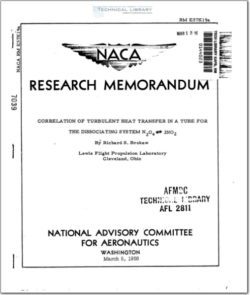NACA-RM-E57k19a

- Version
- 132 Downloads
- 657.32 KB File Size
- 1 File Count
- December 4, 2015 Create Date
- December 4, 2015 Last Updated
National Advisory Committee for Aeronautics, Research Memorandum - Correlation of Turbulent Heat Transfer in a Tube for the Dissociating System N2O4 to 2NO2

Experimental data on turbulent heat transfer in a tube for the dis-
sociating system H204 ItZNOZ are in accord with the usual Russelt-
Prandtl—Reynolds number correlation for this type of convective heat
transfer.
The thermal conductivities and kinematic viscosities needed to
formulate the Ensselt, Reynolds, and Prandtl numbers have been computed
using rigorous expressions from the kinetic theory of gases. The thermal
conductivity includes a large contribution arising from the diffusional
transport of chemical enthalpy.
Three methods of selecting average property values for the boundary
layer were tested. All gave good correlation using the equilibrium trans-
port properties.
An approximate method using frozen gas properties gave somewhat poorer
results, but should be useful for complex systems where exact computations
would be prohibitively tedious. This approximate method should also be
applicable to systems in which chemical equilibrium is not attained, pro-
vided the enthalpy of the gases in the free stream and at the wall is
known.
Currently there is considerable interest in heat transfer in disso—
ciating gases, because such gases may exist in the exhaust nozzles of Jet
engines or within the boundary layer on hypersonic aircraft. In reacting
gases, heat transport may be considerably higher than in "frozen" (non-
reacting) mixtures. Large amounts of heat may be carried as chemical
enthalpy of molecules which diffuse because of concentration gradients.
These gradients arise because the gas composition varies with temperature.
For example, in a gas which absorbs heat by dissociating as the temper-
ature is raised, heat is transferred when a molecule dissociates in the
high-temperature region and diffuses toward the low-temperature region
(there is a lower concentration of dissociated molecules at low temper—
ature). In the low-temperature region the_gas reassociates, releasing
the heat absorbed from the high-temperature dissociation.
| File | Action |
|---|---|
| naca-rm-e57k19a.pdf | Download |

Comment On This Post